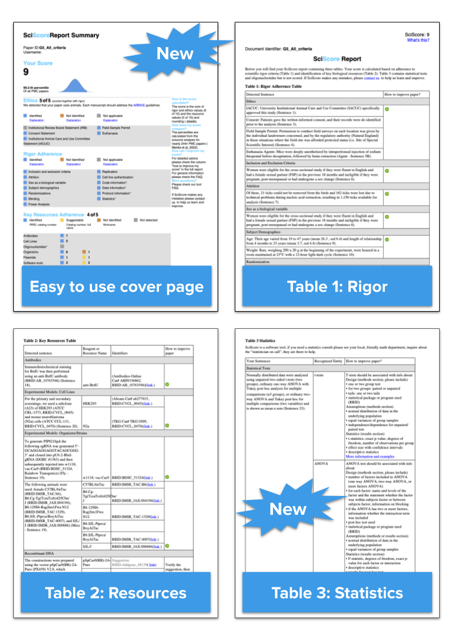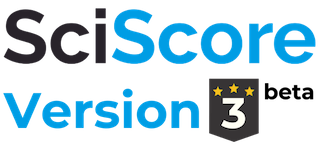Core Report
The SciScore core report is an automated assessment of a research paper’s methodologies and reporting that combines criteria from a variety of NIH-supported principles and guidelines, such as ARRIVE, CONSORT, and MDAR. It includes three tables and a reporting score. The report primarily covers rigor adherence and key resource identification to help promote reproducibility in life science research.
The reporting score - a score out of 10 - is a number researchers, journal editors, and funders can use to help them decide how rigorous and transparent a research manuscript is. The score is based on both rigor adherence and key resource identification within the materials and methods sections. A good score is essential to help ensure that interested parties have enough information to accurately judge the reproducibility of a research article. If your SciScore is not where you want it to be, don’t worry; improving your score can be as simple as adding an identifier. In general though, the more information, the better.



Rigor Table:
In the rigor table (Table 1), SciScore highlights sentences that include various elements of rigor as described by Hackam and Redelmeier in 2006, and by van der Warp and colleagues in 2010. SciScore was trained using sentences from thousands of published papers that were tagged by expert curators to indicate that the sentence described a rigor criterion such as blinding (either during the experiment or during data analysis). SciScore looks for items listed on the report and when an item is detected, the sentence is included, when an item is not detected, the tool reports "not detected". It is possible that a criterion is not necessary for a particular manuscript. In these cases, the score is not decreased by a "not detected". For example, if an IRB section is not filled in, but no animals or human participants are detected. SciScore, an automated tool, can also make a mistake. If SciScore makes substantial mistakes with your manuscript, please contact us to help us learn from our mistakes.
Key Resources Table:
The key resources table (Table 2), contains:
- Sentences that “should” have RRIDs
Key biological resources detected (names of cell lines or antibodies)
RRIDs - if detected, these are checked / validated by SciScore
Statistics Table:
The statistics table (Table 3), contains information about test recognizable by SciScore:
- T-test
- Welch’s t-test
- Z-test
- ANOVA, ANCOVA and post hoc tests
- Mann-Whitney U test
- Wilcoxon test
- Kruskal-Wallis test
- Correlation tests : Pearson’s , Spearman’s rank and Kendall’s tau test
- Regression analysis
- Chi-square test
- Fisher’s exact test
- Friedmann test
- Binomial test
- D’Agostino - Pearson omnibus test
